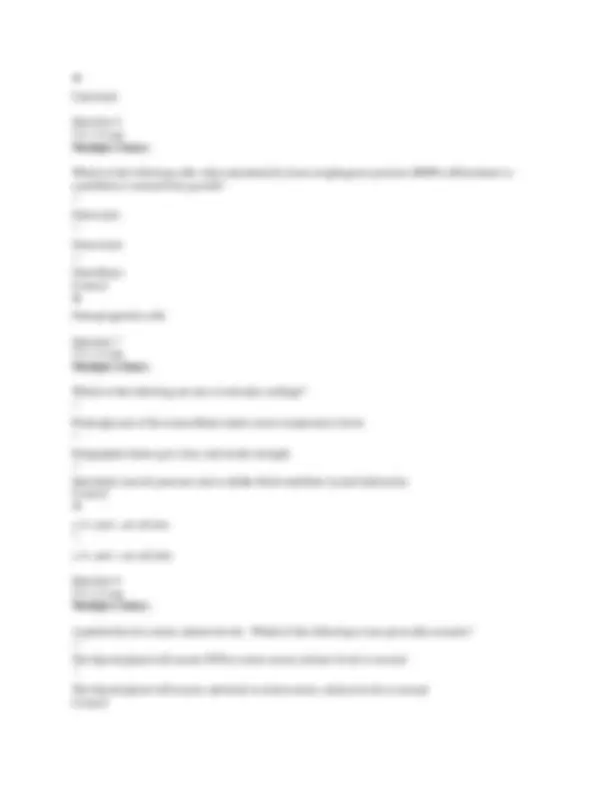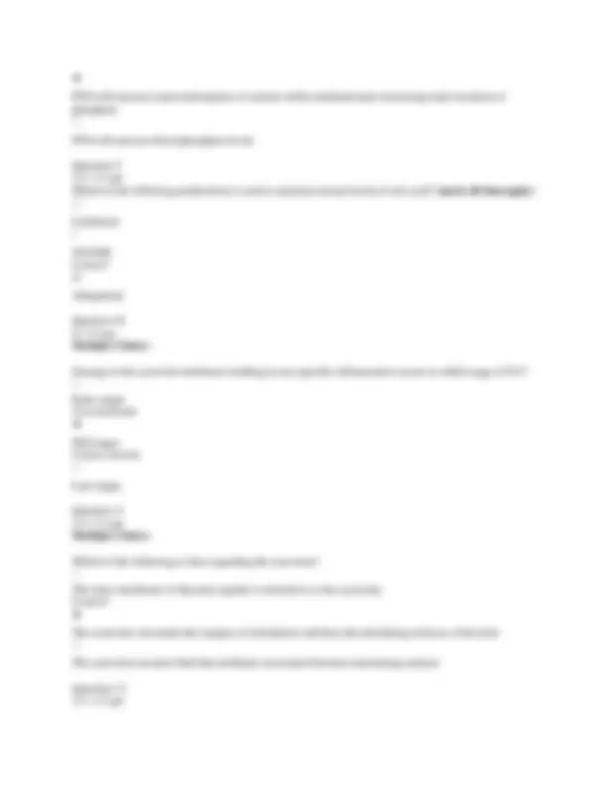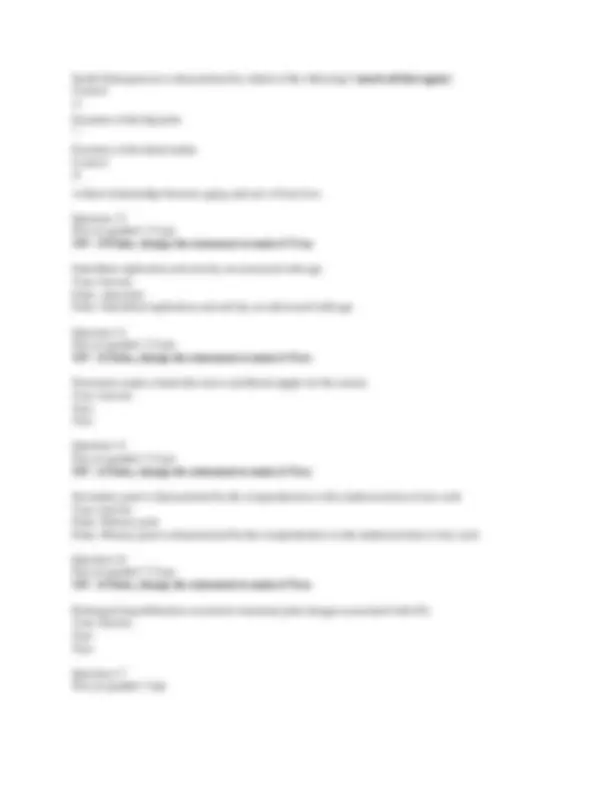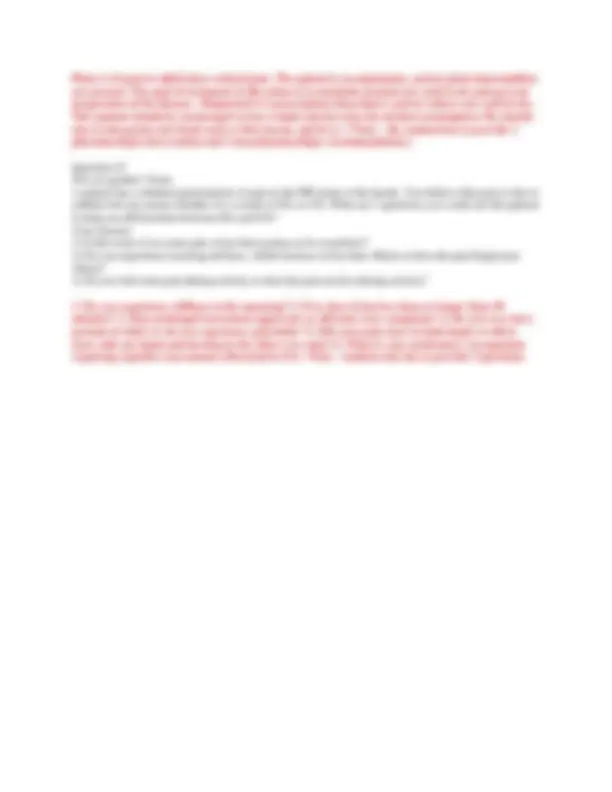






Study with the several resources on Docsity

Earn points by helping other students or get them with a premium plan


Prepare for your exams
Study with the several resources on Docsity

Earn points to download
Earn points by helping other students or get them with a premium plan
Community
Ask the community for help and clear up your study doubts
Discover the best universities in your country according to Docsity users
Free resources
Download our free guides on studying techniques, anxiety management strategies, and thesis advice from Docsity tutors
A series of multiple choice and true/false questions covering key concepts in the pathophysiology of bone and joint disorders. It provides a comprehensive assessment of understanding related to topics such as gout, osteoarthritis, osteoporosis, and the structure and function of bone and cartilage. The questions are designed to test knowledge of various aspects of these disorders, including their causes, symptoms, treatments, and risk factors. This resource is valuable for students studying anatomy, physiology, and related healthcare fields.
Typology: Exams
1 / 8

This page cannot be seen from the preview
Don't miss anything!





Question 1 2.5 / 2.5 pts Multiple Choice: Each of the following are true of gout except: Correct! Uric acid dissolves readily in synovial fluid Typically occurs at the first metatarsophalangeal joint Anyone can get gout Uric acid is a byproduct of purine metabolism Question 2 2.5 / 2.5 pts Multiple Choice: Which of the following would a patient likely report if you suspect they have OA? Stiffness in the morning that lasts longer than 30 minutes Pain that is alleviated with activity Correct!
A “grinding feel” with movement Pain in their MCP joint Question 3 2.5 / 2.5 pts Which of the following are true regarding synovial joints? (mark all that apply) Ball and socket joints are characterized by limited range of motion Correct! Condyloid joints allow gliding of irregular joint surfaces Correct! They are freely moving The synovium lines articulating surfaces of the joint Correct! The synovium surrounds the joint margins Question 4 2.5 / 2.5 pts Multiple Choice: Cancellous bone receives its blood supply by what means? Arteries branching from the medullary cavity Arteries branching inward from the periosteal arteries Correct! Diffusion through the endosteal surface of the bone and the canaliculi Question 5 0 / 2.5 pts Multiple Choice: Which of the following drugs is most commonly prescribed to treat osteoporosis? Raloxifene Correct Answer Alendronate You Answered
PTH will increase renal reabsorption of calcium while simultaneously increasing renal excretion of phosphate PTH will increase blood phosphate levels Question 9 2.5 / 2.5 pts Which of the following medications is used to maintain normal levels of uric acid? (mark all that apply) Colchicine NSAIDS Correct! Allopurinol Question 10 0 / 2.5 pts Multiple Choice: Damage to the synovial membrane resulting in non-specific inflammation occurs in which stage of OA? Early stages You Answered Mid stages Correct Answer Late stages Question 11 2.5 / 2.5 pts Multiple Choice: Which of the following is false regarding the synovium? The inner membrane of the joint capsule is referred to as the synovium Correct! The synovium surrounds the margins of articulation and lines the articulating surfaces of the joint The synovium secretes fluid that facilitates movement between articulating surfaces Question 12 2.5 / 2.5 pts
Senile Osteoporosis is characterized by which of the following? (mark all that apply) Correct! Fractures of the hip joint Fractures of the distal radius Correct! A direct relationship between aging and rate of bone loss Question 13 Not yet graded / 2.5 pts T/F – If False, change the statement to make it True Osteoblast replication and activity are increased with age. Your Answer: False. osteoclast False, Osteoblast replication and activity are decreased with age. Question 14 Not yet graded / 2.5 pts T/F – if False, change the statement to make it True Haversian canals contain the nerve and blood supply for the osteon. Your Answer: True True Question 15 Not yet graded / 2.5 pts T/F – if False, change the statement to make it True Secondary gout is characterized by the overproduction or the underexcretion of uric acid. Your Answer: False. Primary gout False, Primary gout is characterized by the overproduction or the underexcretion of uric acid. Question 16 Not yet graded / 2.5 pts T/F – if False, change the statement to make it True Prolonged immobilization can lead to structural joint changes associated with OA. Your Answer: True True Question 17 Not yet graded / 5 pts
Not yet graded / 5 pts Compare and contrast the blood supply of cortical bone and cancellous bone. Your Answer: Cortical bones receive blood supply from nutrient and perforating arteries. Blood is circulated via the central haversion and volkmann canals. Cancellous bones receives blood differently. Instead of receiving blood by vessels, it receives blood via diffusion. It begins at the endoseal surface of the tissue and extends outward through the cancaliculi. Cortical bone has a direct blood supply. Nutrient and Perforating arteries form an anastomosis (collateral circulation) that circulates through the bone through the Haversian and Volkmann canals. Cancellous bone does not have a direct blood supply. It receives its blood supply through diffusion from the endosteal bone surface extending outward through the canaliculi. Question 22 Not yet graded / 5 pts A 22-year-old competitive gymnast has experienced amenorrhea for the past 5 years. Her PCP is suspecting that she may have premature osteoporosis. Would you expect her RANKL levels to be high, normal, or low? Explain why her levels would be at this level. Your Answer: WIth 5 years of amenorrhea, this can result in a decline in overall estrogen levels. This will result in high RANKL levels. Estrogen increases the production of OPG, which lowers the rate of osteoclasts. Low levels of estrogen will result in low levels of OPG, which will lead to higher rates of osteoclast activity. Her RANKL levels would be higher than normal. Amenorrhea results in lower estrogen levels. Estrogen increases the production of OPG which inhibits RANKL. Lower estrogen levels would lead to lower OPG levels in turn increasing RANKL and osteoclast activity. Question 23 Not yet graded / 10 pts A 68-year-old, white Caucasian female has a DEXA scan at the recommendation of her PCP. Her scan yielded a T-score of - 0.9. Interpret the results of her DEXA scan. Develop a treatment plan giving a pharmacologic recommendation if applicable (be specific with name of supplement and/or class of drug), and a non-pharmacologic recommendation. Your Answer: T-score of - 1.0 and above are considerd normal bone density. This patient is borderline, so its important that the patient take regular and adequate calcium, as well as incorporate weight bearing excercises. Recommended for postmenapausal women is 1500mg of calcium. This can be consumed via diet or supplements. Vitamin D supplements, between 400 and 800IUs, should be consumed as well. Vitamin D increases calcium absroption. This T-score indicates normal bone density; however, because of this patient’s age, race, and gender, she should take a Calcium supplement as well as a Vitamin D supplement. She should also be participating in regular weight bearing activities such as walking or even resistance exercise. Question 24 Not yet graded / 10 pts A 72 - year-old male is said to be in phase 3 of gout. He is obese and has a history of alcohol abuse. Develop a treatment plan including specific pharmacologic intervention and a non-pharmacologic recommendation to manage his disease. Your Answer: During this inter-critical phase, preventing future attacks is key. Its important to get the uric acid levels under control. Allopurinol or a uricosuric drug can be used to reduce the uric acid. Lifestyle changes, such as decreasing alcohol consumption, avoiding foods rich in purines (fish, shellfish, bacon), and maintaning a healthy weight, can help in preventing future attacks.
Phase 3 of gout is called inter-critical gout. The patient is asymptomatic, and no joint abnormalities are present. The goal of treatment in this phase is to maintain normal uric acid levels and prevent progression of the disease. Allopurinol is a prescription drug that is used to reduce uric acid levels. This patient should be encouraged to lose weight and decrease his alcohol consumption. He should also avoid purine rich foods such as fish, bacon, and liver. (Note – the student has to provide 1 pharmacologic intervention and 1 non-pharmacologic recommendation.)* Question 25 Not yet graded / 10 pts A patient has a bilateral presentation of pain in the PIP joints of the hands. You believe this pain is due to arthritis but are unsure whether it is a result of RA or OA. What are 3 questions you could ask this patient to help you differentiate between RA and OA? Your Answer:
*1. Do you experience stiffness in the morning? 2. If so, does it last less than or longer than 30 minutes? 3. Does prolonged movement aggravate or alleviate your symptoms? 4. Do you ever have periods of relief, or do you experience pain daily? 5. Did your pain start in both hands or did it start with one hand and develop in the other over time? 6. What is your profession? (occupations requiring repetitive movements often lead to OA) Note – student only has to provide 3 questions.